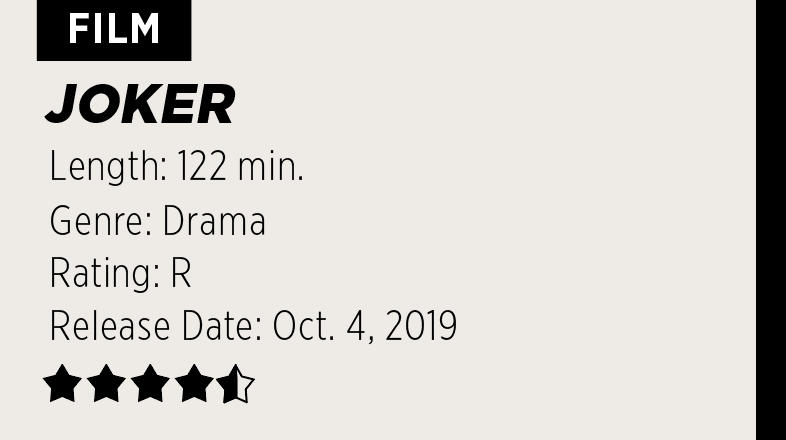REVIEW: ‘Joker’ reveals classic character’s dark backstory

Arthur Fleck twirls, twirls and twirls a sign, enclothed in full clown attire — he dances and smiles without a worry in the world. Everyone walks by him, creeped out more than anything.
But that doesn’t matter to Fleck, who is enjoying himself as he forgets how he’s perceived by the world. When a group of teenagers steals his sign, Fleck jolts back into reality. As he sprints to retrieve it, Fleck is hit by the sign, which ruptures in pieces. He lies on the floor as the teenagers laugh at the expense of his pain. He’s broken. Broken by society.
Todd Phillips’ “Joker” is a chilling character study of the most iconic supervillain in comic book lore. The movie explores how a man who has dealt with mental health issues, physical abuse and psychological torment at the hands of society can descend into an irreversible path of violence.
Fleck, played by Joaquin Phoenix, has been released from a psychiatric hospital. Loads of medication and mandatory sessions with an uninterested social worker keep him away from losing all sense of himself — that is, until the program is cut. He now lives with his mother Penny (Frances Conroy), who seems to only want to talk about Gotham billionaire Thomas Wayne (Brett Cullen). He idolizes late-night talk show host Murray Franklin (Robert de Niro) and hopes to one day become a stand-up comedian.
When word gets around that Fleck was assaulted by a group of teenagers, one of his coworkers gives him a gun under the assumption that he’ll use it when in danger. This is the beginning of Fleck’s descent into madness, one that will cause him to lash out against those who have wronged him.
Lawrence Sher’s gritty cinematography captures Gotham City as a desolate place, with graffiti-laden streets, rundown infrastructure and pollution ravaging the city. Capturing Gotham disparagingly highlights how hope has been lost not just by Fleck but also by the city’s residents, who are on the brink of rioting to make their voices heard. The setting captures the same mood as in Martin Scorcese’s “Taxi Driver,” a major inspiration for Phillips. Fleck strikes a clear parallel to Travis Bickle: Both men have been deemed outsiders of society, and lashing out is their only perceived way to retaliate — and to ensure that the world listens.
Plenty of controversy surrounded the film prior to its release. Worries about glorifying violence or sympathizing with Fleck have raised questions. But just like “Taxi Driver,” “Joker” is a cautionary tale of what happens when society fails people.
Phoenix is at his very best in this role, toeing the line between sympathy and utter fear. His mannerisms and maniacal laugh, a medical condition, make it clear that Fleck is a troubled man. Audiences can sympathize with the trauma that he has endured, but viewers are repulsed by him moments later when he lashes out. Although there are many differences between Phoenix’s portrayal and Heath Ledger’s, Phoenix is sure to be an Oscar favorite for this role.
What makes this film such a disturbing experience is the bombastic score from Hildur Guðnadóttir, whose use of the cello generates an eerie tone that resembles Fleck’s jagged mindset. Some of the song choices used in the film are a bit too on the nose, but they are used effectively.
The film builds up, slowly leading to the inevitable turn from Fleck to the Joker and culminating in a third act filled with surprises and bloodshed as the clown completely turns on society. Expect to be confounded.
“Joker” reinvents the proliferated comic book genre that has been tied down to cinematic universes, Thanos-level threats and post-credit stingers for a personal character study that explains the origins of a man who turns to violence. This film isn’t a glorification of men like Fleck who revel in chaos but is focused on the question: What level of accountability do we hold, or should we hold, for neglecting people who are already isolated and suffer from mental health issues?


